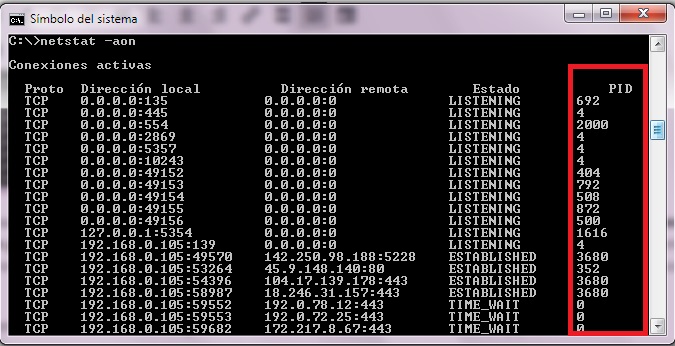
- JAVA VER PUERTOS ABIERTOS INSTALL
- JAVA VER PUERTOS ABIERTOS DRIVER
- JAVA VER PUERTOS ABIERTOS WINDOWS
In this way we can know the open ports in Linux. To find the name of the process we will use the following syntax: ps -p PID -o comm =
JAVA VER PUERTOS ABIERTOS INSTALL
For its installation we will use any of the following lines as the case may be: sudo yum install psmisc (Redhat / CentOS) sudo apt install psmisc (Debian / Ubuntu) sudo dnf install psmisc (Fedora 22 and higher) The syntax for use is as follows: merger port # / tcp Thanks to this command we can deploy the PIDs associated with the open ports in Linux. We can see in detail the data of the process, user, etc.

For its installation we will use the following options: sudo yum install lsof (RedHat / CentOS) sudo apt install lsof (Debian / Ubuntu) sudo dnf install lsof (Fedora) Its execution includes the following syntax: lsof -i: port Lsof (LiSt Open Files) is used to deploy all open ports in Linux. n: indicates that it displays numerical addresses.l: Tell netstat to only display the listening ports.
JAVA VER PUERTOS ABIERTOS WINDOWS
It is available on Windows and Linuxįor its installation we can execute the following commands: sudo yum install net-tools (RedHat / CentOS) sudo apt install net-tools (Debian / Ubuntu) sudo dnf install net-tools Fedoraįor its execution we must know the port number to analyze and we will use the grep command to display the information using the following syntax: netstat -ltnp | grep -w ': port #' The result will be as follows: This netstat (Network Statistics) command is often used to display information associated with the network. We can make use of three practical applications for this, these are: Next we will see how we can know the open ports in Linux and Windows operating systems. Ī port indicates the end point of any network communication and is associated with a specific program or service of the operating system. The background initialization time is minimized and is the setting with the most impact to system performance.One of the support and management tasks that we can perform constantly is to check the open TCP ports in the system since in this way we can have the precise control over which service is using that port. At 100%, the background initialization is the highest priority for the controller. A background initialization rate of 0% does not mean that the background initialization is stopped or paused.

At 0%, the background initialization has the lowest priority for the controller, takes the most time to complete, and is the setting with the least impact to system performance. The background initialization rate, configurable between 0% and 100%, represents the percentage of the system resources dedicated to running the background initialization task. These processes cause the background initialization to cancel. Other processes, such as creating a virtual disk, cannot be run concurrently with a background initialization. Some processes such as read and write operations are possible while the background initialization is running. If cancelled, the background initialization automatically restarts within 0 to 5 minutes. The background initialization should be allowed to run to completion. In this regard, the background initialization process is similar to a check consistency. The background initialization process helps the controller identify and correct problems that may occur with the redundant data later. After the background initialization of a RAID 1 virtual disk completes, the physical disks are mirrored. For example, after the background initialization of a RAID 5 virtual disk completes, the parity information has been initialized. The background initialization of a redundant virtual disk prepares the virtual disk to maintain redundant data and improves write performance.

On PERC controllers, background initialization of a redundant virtual disk begins automatically within 0 to 5 minutes after the virtual disk is created.
JAVA VER PUERTOS ABIERTOS DRIVER
NOTE H330, H345 and H355 require the driver to be loaded for the background initialization operations to run.


 0 kommentar(er)
0 kommentar(er)
